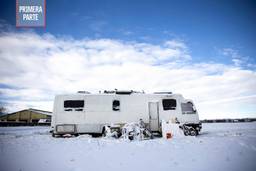“Crisis”: Half of Rural Hospitals Are Operating at a Loss, Hundreds Could Close
A new report paints a grim picture for small-town health care—especially in states that have not expanded Medicaid.
Jazmin Orozco Rodriguez

Editor’s Note: This article was originally published by KFF Health News, a national newsroom that produces in-depth journalism about health issues and is one of the core operating programs at KFF — an independent source of health policy research, polling, and journalism. Learn more about KFF.
In a little more than two years as CEO of a small hospital in Wyoming, Dave Ryerse has witnessed firsthand the worsening financial problems eroding rural hospitals nationwide.
In 2022, Ryerse’s South Lincoln Medical Center was forced to shutter its operating room because it didn’t have the staff to run it 24 hours a day. Soon after, the obstetrics unit closed.
Ryerse said the publicly owned facility’s revenue from providing care has fallen short of operating expenses for at least the past eight years, driving tough decisions to cut services in hopes of keeping the facility open in Kemmerer, a town of about 2,400 in southwestern Wyoming.
South Lincoln’s financial woes aren’t unique, and the risk of hospital closures is an immediate threat to many small communities. “Those cities dry out,” Ryerse said. “There’s a huge sense of urgency to make sure that we can maintain and really eventually thrive in this area.”
A recently released report from the health analytics and consulting firm Chartis paints a clear picture of the grim reality Ryerse and other small-hospital managers face. In its financial analysis, the firm concluded that half of rural hospitals lost money in the past year, up from 43% the previous year. It also identified 418 rural hospitals across the United States that are “vulnerable to closure.”
Mark Holmes, director of the Cecil G. Sheps Center for Health Services Research at the University of North Carolina, said the report’s findings weren’t a surprise, since the financial nosedive it depicted has been a concern of researchers and rural health advocates for decades.
The report noted that small-town hospitals in states that expanded Medicaid eligibility have fared better financially than those in states that didn’t.
Leaders in Montana, whose population is nearly half rural, credit Medicaid expansion as the reason their hospitals have largely avoided the financial crisis depicted by the report despite escalating costs, workforce shortages and growing administrative burden.
“Montana’s expansion of Medicaid coverage to low-income adults nearly 10 years ago has cut in half the percentage of Montanans without insurance, increased access to care and preserved services in rural communities and reduced the burden of uncompensated care shouldered by hospitals by nearly 50%,” said Katy Mack, vice president of communications for the Montana Hospital Association.
Not one hospital has closed in the state since 2015, she added.
Hospitals elsewhere haven’t fared so well.
Michael Topchik, national leader for the Chartis Center for Rural Health and an author of the study, said he expects next year’s update on the report will show rural hospital finances continuing to deteriorate.
“In health care and in many industries, we say, ‘No margin, no mission,’” Topchik said, referring to the difference between income and expenses. Rural hospitals “are all mission-driven organizations that simply don’t have the margin to reinvest in themselves or their communities because of deteriorating margins. I’m very, very concerned for their future.”
People living in rural America are older, sicker and poorer than their urban and suburban counterparts. Yet, they often live in places where many health care services aren’t available, including primary care. The shorter life expectancies in these communities are connected to the lack of success of their health facilities, said Alan Morgan, CEO of the National Rural Health Association, a nonprofit advocacy group.
“We’re really talking about the future of rural here,” Morgan said.
Like South Lincoln, other hospitals still operating are likely cutting services. According to Chartis, nearly a quarter of rural hospitals have closed their obstetrics units and 382 have stopped providing chemotherapy.
Halting services has far-reaching effects on the health of the communities the hospitals and their providers serve.
While people in rural America are more likely to die of cancer than people in urban areas, providing specialty cancer treatment also helps ensure that older adults can stay in their communities. Similarly, obstetrics care helps attract and keep young families.
Whittling services because of financial and staffing problems is causing “death by a thousand cuts,” said Topchik, adding that hospital leaders face choices between keeping the lights on, paying their staff, and serving their communities.
The Chartis report noted that the financial problems are driving hospitals to sell to or otherwise join larger health systems; it said nearly 60% of rural hospitals are now affiliated with large systems. South Lincoln in Wyoming, for example, has a clinical affiliation with Utah-based Intermountain Health, which lets the facility offer access to providers outside the state.
In recent years, rural hospitals have faced many added financial pressures, according to Chartis and other researchers. The rapid growth of rural enrollment in Medicare Advantage plans, which do not reimburse hospitals at the same rate as traditional Medicare, has had a particularly profound effect.
Topchik predicted sustainability for rural health facilities will ultimately require greater investment from Congress.
In 1997, Congress responded to a rural hospital crisis by creating the “Critical Access Hospital” designation, meant to alleviate financial burdens rural hospitals face and help keep health services available by giving facilities cost-based reimbursement rates from Medicare and in some states Medicaid.
But these critical access hospitals are still struggling, including South Lincoln.
In 2021, Congress established a new designation, “Rural Emergency Hospital,” which allows hospitals to cut most inpatient services but continue running outpatient care. The newer designation, with its accompanying financial incentives, has kept some smaller rural hospitals from closing, but Morgan said those conversions still mean a loss of services.
“It’s a good thing that now we keep the emergency room care, but I think it masks the fact that 28 communities lost inpatient care just last year alone,” he said. “I’m afraid that this hospital closure crisis is now going to run under the radar.”
“It ends up costing local and state governments more, ultimately, and costs the federal government more, in dollars for health care treatment,” Morgan said. “It’s just bad public policy. And bad policy for the local communities.”
Jazmin Orozco Rodriguez, Correspondent, is a reporter for KFF Health News’ rural health desk based in Elko, Nevada. She explores the ways health issues affect communities in rural areas, including food security, climate change and agriculture practices. Jazmin joined KFF Health News from The Nevada Independent, where she focused on the state’s Latino and Native American communities. She completed the Poynter Koch Media and Journalism Fellowship in 2021 and was a fellow in the 2019 cohort of the NPR Next Generation Radio Bootcamp. She holds two bachelor’s degrees, in journalism and in Spanish literature and culture, from the University of Nevada-Reno.





